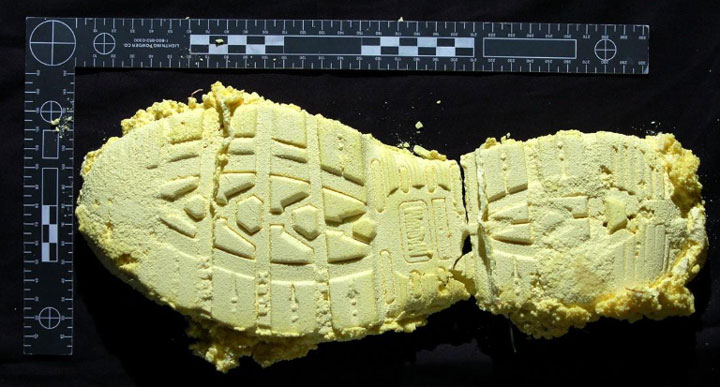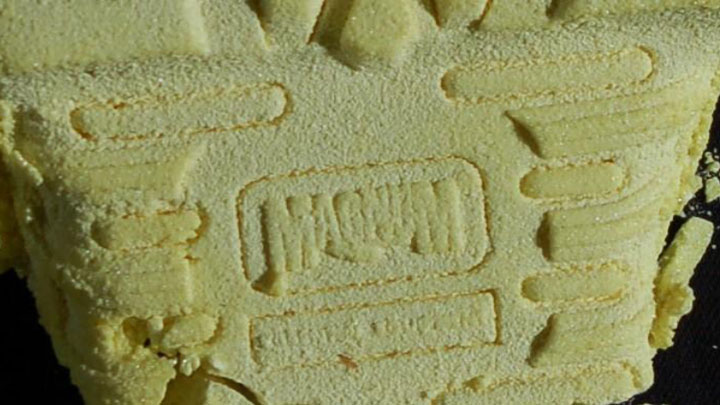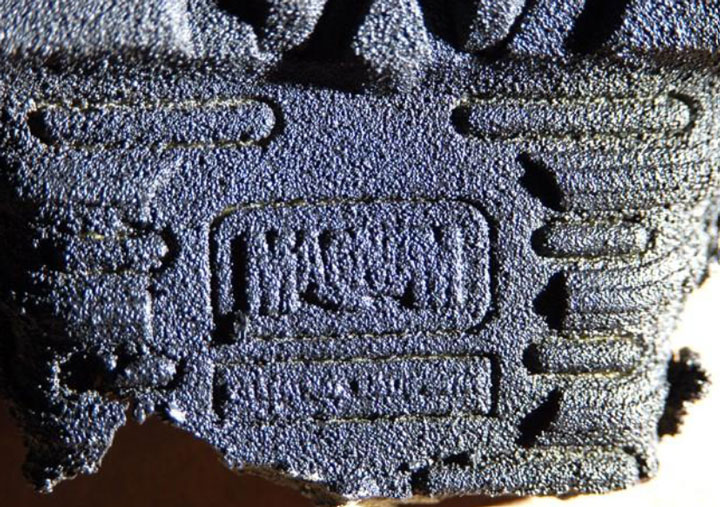Strengthening Sulfur Casts with Plasti-Dip
Thomas W. Adair and Richard Tewes
See also the instructional videos on "Footwear Impressions"
Introduction
Snow impressions of footwear and tire tracks present certain challenges to the crime scene investigator, not the least of which is casting. Several authors have written about these challenges, offering several photographic and casting methods to record the impressions (1,2). Sulfur casting of snow impressions is an accepted method for crime scene investigators, and the preferred method of the authors. Prill or powdered sulfur is heated in an appropriate container to approximately 115 degrees Celsius while constantly stirring. Once the sulfur is liquefied and in the correct temperature range it is removed from heat and allowed to cool while stirring. Once the sulfur cools to a point just above crystallization, it is rapidly poured into a pour channel leading to the impression. This technique can produce excellent casts exhibiting good detail. We agree with Bodziak (1) that it is rare to record the fine detail of scratches and small cuts, however, the same can be said of all snow casting methods. The characteristics of the snow, quality of the footwear, the footwear impression, quality of casting materials, and the methods used to cast the snow impression are all factors influencing the resulting cast. Having said that, in our view, sulfur casting remains the most reliable and effective method for casting snow impressions.
One drawback to sulfur casting is the fragility of the finished cast. Bodziak comments on this issue by saying “Sulfur casts are very fragile and brittle, so extreme care must be exercised when lifting and handling the cast” (pp. 95). Untreated sulfur casts may sometimes break just from the weight of the cast in an unsupported area (such as if it is held only by the heel or toe areas). This presents significant challenges to the crime scene investigator with regards to transportation and storage of the sulfur cast. Sulfur casts are highly susceptible to both splitting (breaking in two or more pieces), and abrasive forces across the outsole area. Even minor abrasive forces may damage or obliterate the fine detail we oftentimes depend upon for individualization. These abrasive forces can even be caused by packaging material used to “protect” the cast while it is being stored as evidence. In addition, unlike dental stone casts, sulfur casts do not break “cleanly” and often have very jagged and fragmented edges. This can make any attempts at re- assembly difficult, if not impossible (Fig. 1). The authors suggest that all sulfur casts be photographed prior to packaging. Many examiners and students have experienced sulfur casts breaking at the time of removal from the snow substrate. Some examiners have suggested the application of a layer of dental stone to the back of the cast. While this process may reduce the chances of splitting it provides no protection from abrasive grinding and/or chipping to the outsole portion of the cast.

Figure 1
Materials and Applied Methods
During a recent training class in the mountain town of Dillon, Colorado (USA), a student approached the authors and asked if we had ever cast snow impressions with a product called Plasti-dip. Plasti-dip, a product of the Performix brand name, is a multi-purpose rubber coating material found in many hardware stores. The product is widely used to add rubber coatings to tools, counters, foot rests and for weather proofing items. The product is available in both liquid and aerosol form with several colors to choose from. The authors had never used the product and set out to experiment on the viability of its use in snow casting. It was decided that the aerosol product would produce the best results and it was applied in the same manner as one would snow print wax. The aerosol product worked very well in highlighting the impression for photography. In this regard it performed as well or better than snow print wax. There was no clogging or “sputtering” of product as one may encounter with an aerosol wax. Plasti-dip, however, has a very long set up time (several hours) making it impractical for crime scene work. Often times, the dark color of the product absorbed heat and served to partially melt the impression prior to casting with dental stone. For these reasons it seems impractical for use in direct casting of snow impressions.
The authors did consider the protective qualities advertised by the manufacturer. It was theorized that light coats of the product would serve to form a protective coating of the cast and limit the possibility of splitting and abrasive damage. Several sulfur casts were coated with the Plasti-dip product, producing excellent results. The casts were laid out with the outsole area facing up. A light coating of the product was sprayed onto the impression from a distance of about 8”-10”. The product was sprayed from all four perimeters of the cast (lateral, toe, medial, and heel). This is the same technique recommended for applying snow print wax to a snow impression. A total of five coats were applied to the cast with 15-30 minute intervals between coats. After the final coat, casts were allowed to dry and cure overnight. The cast is then placed outsole down and the back and sides of the cast are then coated. It is important to create a complete shell around the cast to gain the greatest protection from damaging forces. Figures 2 and 3 show a logo area of a sulfur cast both before and after the application of Plasti-dip. The Plasti-dip coating provided an extremely tough protective layer with minimal to negligible effects on detail. Casts could be firmly tapped against a hard countertop without breakage. Minimizing the loss of detail through the application of the aerosol product is best achieved by the light application of coats. Applying too heavy a coat increases the chance of filling in fine detail. Given the alternative, however, it seems that even an over application of product would be better than the more severe damage that may occur to an unprotected cast.

Figure 2

Figure 3
Discussion
The biggest drawback to sulfur casting has always been the fragility of the cast. Most methods to strengthen sulfur casts have been limited to the creation of a rigid backing. While this can reduce the chances of splitting the cast into smaller pieces, it offers no protection for the outsole area. Plasti-dip has been shown to provide excellent strengthening qualities while preserving good detail in the pattern area. The best results were achieved when applying the aerosol product in light coats. Examiners may wish to apply 2-3 light coats to the cast at the crime scene to help protect it during transport. Once fully cured the coating provides considerable strength, making damage to the cast unlikely. This process can obviously be applied to already broken casts as well. Examiners should consider the application of this protective coating to case evidence already in custody to minimize further damage resulting from normal evidence handling. Practice of this technique is recommended to achieve the desired results. Other commercial products or methods may exist which may also strengthen sulfur casts. Methods employed by other examiners should be reported to broaden our knowledge and ability to protect this valuable evidence.
References
- Bodziak, W.J. 1995. Footwear Impression Evidence. CRC Press, Boca Raton FL. 421 pps.
- Cassidy, M.J. 1995. Footwear Identification. Lightning powder Company. Salem, OR. 176 pps.
Acknowledgement:
The authors extend our gratitude to Mr. Micah Richardson of the Dillon Police Department for suggesting the testing of this product.
About the Authors
Thomas W. Adair
Senior Criminalist
Westminster Police Department
9110 Yates Street
Westminster, CO 80031
Richard Tewes
Manager of Forensic Services
Fort Collins Police Department
300 LaPorte Ave
Fort Collins, CO 80521
 This is an Open Access article distributed under the terms of the Creative Commons Attribution-NonCommercial-NoDerivatives 4.0 International License which permits unrestricted noncommercial use, distribution, and reproduction, provided the original work is properly cited and not changed in any way.
This is an Open Access article distributed under the terms of the Creative Commons Attribution-NonCommercial-NoDerivatives 4.0 International License which permits unrestricted noncommercial use, distribution, and reproduction, provided the original work is properly cited and not changed in any way.
Article submitted by the authors. The Crime Scene Investigator Network gratefully acknowledges the authors for allowing us to reproduce the article .

